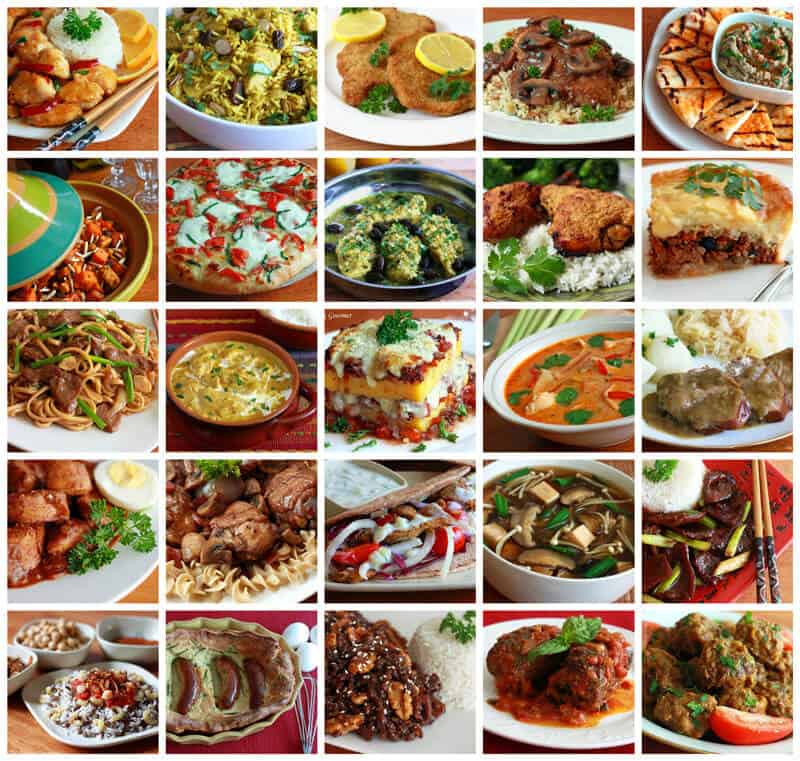The American Kitchen: The World’s Melting Pot
This post may contain affiliate links. See my disclosure policy.
Thank you to GE Appliances and BlogHer for sponsoring this post!
 What comes to mind when you hear the term “The American Kitchen?” That was the question I was posed when invited to write a post on the subject. GE Appliances has been part of the American home since 1905 and now, a hundred and ten years later, is launching a documentary series called Our American Kitchen which will explore real lives and the common themes that bind us – all centered in what is the heart of the American home: The kitchen. As I reflected on the term “The American Kitchen,” the first thing that came to mind was “melting pot.” A place where family and food converge in a way that is meaningful and unique. The American Kitchen is a melting pot not only in that it gathers in a large diversity of people and cultures, it is also a melting pot in that sense that it gathers in food from across the entire globe. In a very real sense, the American Kitchen is the Melting Pot of the World.
What comes to mind when you hear the term “The American Kitchen?” That was the question I was posed when invited to write a post on the subject. GE Appliances has been part of the American home since 1905 and now, a hundred and ten years later, is launching a documentary series called Our American Kitchen which will explore real lives and the common themes that bind us – all centered in what is the heart of the American home: The kitchen. As I reflected on the term “The American Kitchen,” the first thing that came to mind was “melting pot.” A place where family and food converge in a way that is meaningful and unique. The American Kitchen is a melting pot not only in that it gathers in a large diversity of people and cultures, it is also a melting pot in that sense that it gathers in food from across the entire globe. In a very real sense, the American Kitchen is the Melting Pot of the World.
I grew up in Europe, traveled to many countries, and grew to love the cuisines of the world. As hard as it was to leave my home and move to the United States, something I really appreciated when I arrived was discovering how diverse the food is here. International food is my passion, it’s my language, and no matter where I travel in the U.S., I’m able to find my language spoken wherever I go.
That kind of diversity doesn’t exist anywhere else in the world – not to the same extent. Though you can certainly find a variety of ethnic restaurants within the same country throughout Europe and other parts of the world, it’s not anything like it is here. Here I can jump in my car and travel a few miles in any direction and have my choice of Thai, Middle Eastern, Indian, Greek, Ethiopian, Afghan, Eastern European, German, Italian, French, Spanish, Chinese, British, Mexican, Japanese, Vietnamese, West African, Moroccan, Brazilian, Peruvian, and the list goes on and on.
As someone who is a passionate cook, I can immerse myself in any cuisine I want without having to travel too far. I can create all those foods that I love in my own kitchen and share them with the people I love. And those world cuisines, those precious bonding moments, lie just at my fingertips.

For me, cooking international cuisine in my American kitchen is the perfect blending. And that’s because it is here that these cultures are better represented than anywhere else in the world. For every ethnic dish I’ve made, I’ve met someone here in the U.S. from that country. And it is always so rewarding to talk a common language with them: Food. Just recently I attended a conference in Seattle and as I was driving out of the parking garage I noticed that the black parking attendant spoke with an accent. I asked him where he was from and he said Ethiopia. I got excited and told him I had recently posted a dish for Doro Wat, Ethiopia’s national dish, on my blog. Then he got excited and we found ourselves talking about food for a good 5 minutes before another car came up behind me and I was forced to leave.
But we parted with some kind words and wave goodbye – an Ethiopian and a German in America having made a meaningful connection.
Here are just a few of the international dishes I’ve made in my American kitchen that are here on my blog. Each of them meaningful to me for different reasons, and each of them a reflection of personal experiences and connections.

Americans in general have a broader taste tolerance for food and a wider range of culinary offerings than perhaps any other nation. Why? It’s rooted in American history, it’s part of our young but rich heritage.
First and foremost, we are a nation of immigrants – from everywhere. It’s no surprise that our cuisine is an international mosaic.
Secondly, American cuisine has been inspired by the tradition of survival in the face of harsh odds. Of necessity as early Americans settled new territories they relied on hunting wild game for their food. Even this was unique compared to their European heritage where hunting was for the elite and done purely for sport. In the wild where beggars couldn’t be choosers, American settlers had to accept whatever happened to jump in front of the barrel of their rifles and take home such entrees as squirrel, rattlesnake, alligator and bear. Again, when you don’t care what you eat you’re open to more and the struggle to survive helped broaden the American palate. Indeed, the need to survive overshadows the luxury of food preferences. That opened the doors to greater acceptance and willingness to explore other foods. It meant that early Americans were “open to any number of unexpected culinary influences that might, one way or another, quietly shape the national diet while citizens were otherwise preoccupied with more remunerative endeavors.” (PS Magazine, What Makes American Cuisine American?, February 4, 2014).
And so American food culture is one of “radical flexibility, constantly shifting standards, a lack of [long] tradition, an emphasis on convenience, a penchant for innovation, and an unwavering dedication to any and all “curious ragoos”— [and it] has mutated into an upgraded food system that playfully incorporates haute cuisine with TV dinners, fast food with slow food, local with global, anything with everything” (ibid).
America is now my home. It is the home of my children. And because of my background and my own love for other people and cultures, I want to share that with my family. Our kitchen is the gathering place of our home. From morning until night, that is the room to which our family gravitates the most. As such our kitchen is also a place of learning. From the convenience of our kitchen, I can share the world with my children through the food we prepare and eat together. Here in the melting pot of our home I can instill in them a love and appreciation for the beauty of other lands, cultures, customs and traditions. I can teach my kids about Ethiopia, Hungary, and Peru as they help me prepare Doro Wat, Marhapörkölt, and Pollo a la Brassa. And then we can sit down together as a family to enjoy a meal, to reconnect at the end of each day, and to experience those bonding moments that are more precious than the world itself.
Welcome to My American Kitchen.

Sweepstakes Time: Enter to win a $100 VISA gift card.
This giveaway has ended.



















tweeted https://twitter.com/thepryfamily2/status/591687451841830912
it makes me think of grandma’s cookies and a hot apple pie :)
The American Kitchen is one in which family comes together and connects.
A place where families gather to cook and share about their day.
I tweeted
https://twitter.com/my4boysand1/status/590728085454086144
When I think of “Our American Kitchen” love and warmth! Bring the whole family together!
My kitchen means lots of warm memories and laughter with friends and family over a home cooked meal!
I learned about our American kitchen when I was a girl, cooking with my Sicilian Grandma. She was the first child in her family to be born here in America. She passed on to me the habits of generations of women who had held their families together in the heart of the home, creating from the lush Sicilian country the simple robust meals that fueled the family. There was never a day that Grandma Rose couldn’t go to her pantry and freezer and pull out, without advanced warning, a feast for whatever crowd had gathered in her kitchen. The art of a well-stocked pantry, and making what you have on hand perform (in a biblical way) miracles, were her gifts and I have made them mine.
I learned about our American kitchen from my mom, who as a young wife opened her kitchen to new and different cuisines, reaching far beyond the Scotch Irish roots that her mother’s American kitchen stored in abundance. We cooked Coq au Vin from the newly released ‘Mastering the Art…’ and Enchilada Suisse taught to her by a neighbor, and buttery light Dutch Baby pancakes from the pages of Sunset magazine. But on Christmas Eve, every year, we made Cornish pasties and oyster stew, in remembrance of her Welsh miner forefathers. For her birthday on March 18th we feasted on corned beef and soda bread studded with currents. And I learned the pleasure of setting a beautiful table, living graciously no matter the circumstances, the importance of eating well, with family, always.
I created my own American Kitchen with my best friend and husband, who willingly ate shrimp tempura for weeks while I perfected my technique. And chopped and diced and sliced and prepped and grilled endlessly as we created that heart in our own home. We created our first American kitchen in Berkeley, in the heart of the new food movement. Our friends flocked to our tiny house to share meals. Without realizing it, we were the California Cuisine generation. We discovered the farmers market at Alemany and the small growing Napa wine country and brought it all back to our tiny apartment kitchen. My mother’s now worn copy of Julia Child, Alice Waters, James Beard and ‘America Cooks!’, the family basic compendium cookbook, lived on a small shelf over the fridge.
I am helping my daughter create her American Kitchen now. At 22 she has been exposed to food from all over the globe, right in our own home. She has her own copies of ‘Mastering the Art, and ‘America Cooks!’ and ‘Cooking with Fanny’ along with a few other favorites. She calls me from her tiny American kitchen with questions about cooking time, and temps, and how much salt? In her voice I hear my grandma, and my mom, echoing me as I answer her and guide her in her efforts to feed herself and roommates and friends, just as I did when I was her age. And I know that at some point I will listen to her, on the phone, saying “it’s one egg per person for the Dutch babies, and then increase the flour and milk” to her own child.
It occurs to me that our American Kitchen isn’t a room in the house. It’s the people in the room. And the heart of the home. It beats. It makes the rest of our home come alive. It is always the space where, in times of celebration and in times of sorrow, we gather. That is our American Kitchen!
Beautiful, Sara. I hope you print this out and put it somewhere for safekeeping for you daughter, grandchildren and great-grandchildren to read someday.